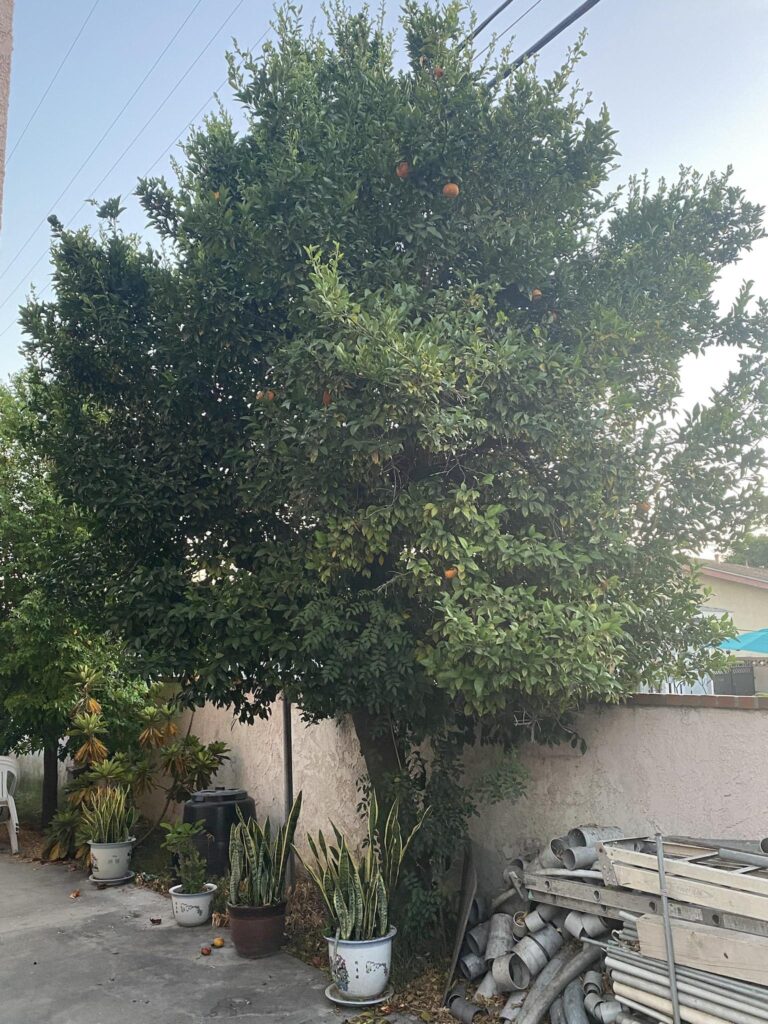In Florida, the roof rat causes the most damage. Also known as the fruit rat, palm rat, and citrus rat, these arboreal rodents can travel through trees similar to a squirrel. They build leaf and twig nests in citrus trees or skirts of old fronds on palm trees.
Because they are nocturnal, rats in trees usually go undetected until the Florida citrus season.
protect your citrus trees from palm rats
Your fruit trees should be isolated, not touching fences, overhead wires, or the branches of other trees. Palm rats will run along fences, wires, poles, and tree branches to reach your fruit trees.
Clean up all fallen fruit!
Lower branches of the tree should not touch the ground. A low-hanging skirt of drooping branches give the rats additional access routes and provides them with protective cover while feeding. Prune fruit trees so that the base of the tree is exposed, which will make the rat uncomfortable and more susceptible to predators.
Rat guards on the trunks will keep the rats out of trees. Rat guards can be as simple as a piece of sheet metal 18–24 inches wide and as long as the circumference of the tree plus two inches. If wires go through the crown of the tree or your tree touches a fence or branches of another tree, then rat guards are useless—the tree must be isolated for rat guards to work.
How to Install Rat Guards on Citrus Trees:
Secure the ends of the sheet metal with a piece of wire bent like a staple. Do not penetrate the tree.
Insert the two ends of the wire through holes in the sheet metal
Put bac of the wire against the tree’s trunk
Bend the wire outward to hold the ends of the rat guard together.
If your tree has a short or forked trunk, then a sheet metal wall, 2 feet tall (60 cm), around the tree will reduce rodent access to it.

Palm Rat Trapping
Rat traps are consistently the most effective method for rat population control. Poisoned rats can find their way into a building and die causing an odor. Some predators can prey on poisoned rats.
The tree can also be protected by tying several rat traps around the trunk of the tree with the triggers pointing down. Use expanded trigger rat traps on trees and fences. Be sure to tie the traps securely to the trunk before trying to set the traps.
Because rats are nocturnal, set rat traps from dusk until dawn. This will prevent killing non-target animals like squirrels and protected birds, such as wrens, woodpeckers, chickadees, etc.
Since rats prefer to stay off the ground, they like to run along the stringer boards of fences and the horizontal support poles of chain link fences. Traps can be nailed directly to the horizontal stringer board of wooden fences. Place a protective board above the trap to discourage birds from accidentally getting in the trap.
Roof rats are nervous and cautious of new objects in their environment, so leave traps in the same location for at least a week before moving them.
Rat Bait Sations
Although they might look like a trap, bait stations or bait boxes are not a rodent trap. Bait stations contain a solid, liquid, or paste rodenticides, and increase the effectiveness and safety of rodenticides. Bait stations have two holes one for entry and one to exit. After the rodents eat the bait, they leave it. Rodenticides should be used a supplemental control option. If you need to use repeated use of baits, trapping and exclusions services are needed.
If poison baits are used outdoors, they must be placed in a tamper-resistant bait station. All rodenticide labels in Florida state that it is illegal to place any poison rodenticide baits where they are accessible to children, pets, livestock, or wildlife, unless the bait is contained in a secured, tamper-resistant bait station
The practice of wiring poison bait blocks to branches of trees is illegal and has caused thousands of cases of accidental poisoning of dogs and wildlife each year.
In Florida, due to our high humidity, parafinized bait blocks or pellets should be used in any outdoor bait stations. Some municipalities and counties have rodent control programs, but most do not. Contact your local city or county government to find out if there are programs in your area.
There are no repellents registered specifically for roof rats. Since most wildlife repellents cannot be used on human food plants, their usefulness in rat control on fruit trees is extremely limited.
Rat Repellents
You’ll find plenty of rat repellents on the market that claim to keep these rodents away from your home and yard. Unfortunately, there’s little evidence that any of them work. Some can help when applied in large amounts and everywhere that rats could travel. The cost of many commercial repellent products makes that impractical for the average homeowner.
Ultrasonic rat and rodent repellents claim to produce a high-pitched sound you’ll barely hear. They can plug into existing outlets or run off battery power. While they may produce the sound they claim to make, there’s little evidence it bothers rats and other rodents. Many people set up cameras around their ultrasonic rat repellents to find that the animals are passing by without any noticeable reaction to the sound.
Even if you could scare rats away with something as simple as an annoying noise, you’d still have to place so many emitters around your home and property that it would be hard to keep up with changing that many batteries.
Rat-repellent pellets function similarly to sprays by featuring a mix of scents that supposedly discourage rats. Unfortunately, most people who have tried rat-repellent granules have found the pellets scattered around rat nesting areas without any avoidance behavior at all. The rats simply don’t find them bothersome enough to avoid.
